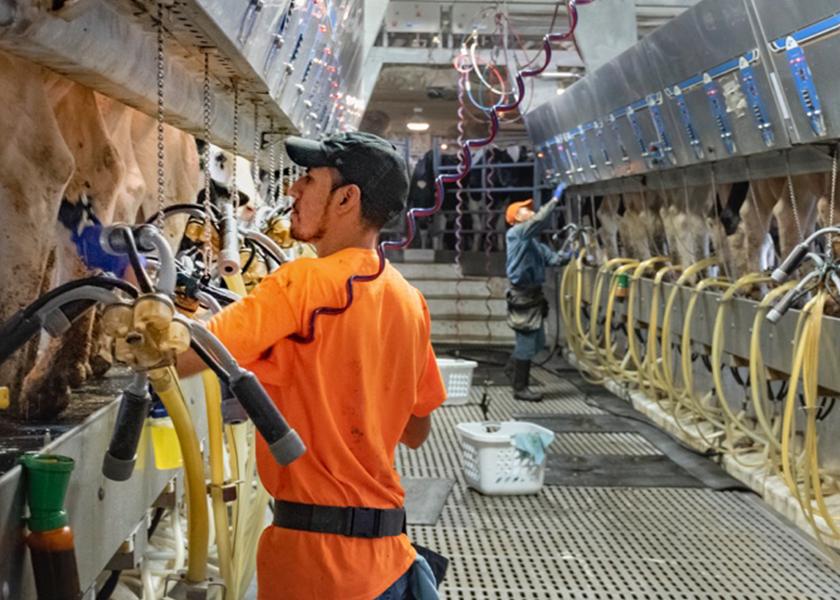A Deep Dive into Workforce Issues Facing Dairy

Despite the fact milk prices have improved in 2022 compared to previous years, one thing has not changed. Labor, or lack of, continues to be a top concern for dairy farmers. Labor struggles in the dairy industry and a sharp focus on the Farm Workforce Modernization Act, was recently discussed during an episode of The Dairy Download from International Dairy Foods Association (IDFA).
Congressman Dan Newhouse spoke about the potential impact the Farm Workforce Modernization Act would have on ag labor. Newhouse says that with the labor-intensive agriculture industry as they have in the state of Washington, the lack of labor to get the work done is the biggest challenge that faces producers in his state.
“That's usually at the top of most people's list, particularly when you're milking cows. Cows don't take a break. They need attention every single day,” he says. “We've had a shortage of labor for quite some time.”
Newsome adds that the ongoing labor challenges that face agriculture are worse now than ever before.
“Our farmers and ranchers in Washington and nationally are dealing with labor shortages and wage pressures,” he says.
Newsome states that farmers are constantly dealing with a shrinking income situation.
“We don’t set a price in the marketplace for what we’re going to produce,” he says. “So, when costs go up, the wages go up that we have to pay our employees. That comes directly out of our bottom line. Farmers are always looking at ways to reduce labor.”
The state of Washington, like several other states, is forced to deal with new labor regulations, such as phasing in a 40-hour workweek over a period of a several years.
“These are not easy things to deal with,” Newhouse adds.
He continued saying it's all a vicious circle and that most people haven’t paused long enough to truly understand why the prices in the grocery store are as high as they are.
Diving into the Farm Workforce Modernization Act, Newhouse says that it’s no secret that a large number of farm workers in the country are challenged with having the proper documentation.
“A lot of people come across the southern border illegally, historically have made up a good chunk of our agricultural workforce, but then a bigger and bigger problem over the last few years. There's been a lot of efforts to restrict illegal movement of people across the border. That’s not happening very successfully right now, I might add. There's a growing concern with a lack of illegal workforce in the agricultural industry, a multi-billion-dollar industry, that is so important for our food security or national security. To have an industry like that dependent to some degree on illegal labor force is just not a great position to be in very tenuous,” he says. “We have been working very hard on our efforts to help the agricultural industry obtain a legal workforce.”
Newhouse says the risk of deportation of an illegal war is huge, especially as we are nearing harvest season. Twice this bill has passed off the floor of the House of Representatives, which Newhouse says is the first in almost 40 years that any major piece of immigration legislation has passed either Chamber of Commerce.
“We are working hard with the Senate to make it a reality in that chamber so that we can get it to the President’s desk to be signed into law. And that’s where we are right now,” Newhouse says. “The ball is in the Senate’s court.”
The Cooperative Viewpoint
Jackie Klipplenstein, senior vice president of government, industry and community relations with Dairy Farmers of America (DFA), shared her efforts that include working with Congress to adjust and expand visa programs to ensure that the cooperative has an adequate workforce.
“Since my first day on the job at DFA, I’ve tried to ensure our farmer owners had an adequate workforce. This has been a huge priority for us working with Congress to try to adjust either current visa programs or create a new one,” she says.
Both the dairy industry and the manufacturing industry have been part of an employee base loss that results in manufacturing companies around the country that are short on workers.
“It's exacerbating the challenge the dairy industry has been facing all these years,” Klippenstein says. “It's posed a huge challenge for us. We don't have enough folks working on farms and not enough folks working in our dairy plants.”
Regarding labor reform, Klippenstein says that there needs to be some major reform, specifically for the dairy sector.
“The current visa programs do not accommodate our needs,” she says. “If you have year-round needs, there is currently not an ag visa program that you can access to secure reliable labor for, so it's been a real challenge for dairy and any other agriculture sector that needs year-round assistance.”
Klippenstein supports the Farm Workforce Modernization Act and says she wants to make sure that the ag sector stays hyper-focused on the opportunity at hand which is the passage of this bill.
“Any legislation that's going through the dairy sector has two interests. One is to ensure that the workers who are currently here working on dairy farms are protected. There is a pathway to some sort of legal status. Number two is that farmers can start accessing a workforce using a visa program. And in the Farm Workforce Modernization Act, the H2A program is amended to allow those who have year-round needs to access the program,” she says. “Those are our two priorities in the dairy sector.”
Klippenstein is optimistic that the bill will get passed sooner rather than later.
“I don't know if the Senate has the wherewithal to get this passed here probably in the lame duck session. But I know that all agriculture is working together to try to make that happen,” she says.
To listen to the full conversation with Newhouse and Klippenstein, log onto www.idfa.org/thedairydownload.







